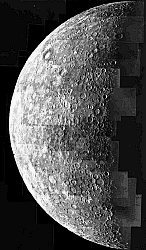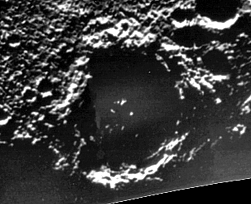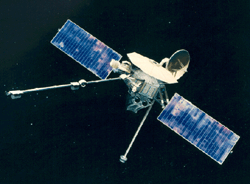Ice on Mercury
The Pre-MESSENGER Picture
The information below gives a historical view of the knowledge of water on Mercury
before the
MESSENGER
mission. Recent observations by MESSENGER of ice at Mercury's poles is described
in a November 29, 2012
press release.

Mercury would seem to be one of the least likely places in the solar system
to find ice. The closest planet to the Sun has temperatures which can reach
over 700 K. The local day on the surface of Mercury is 176 earth-days, so the
surface is slowly rotating under a relentless assault from the Sun.
Nonetheless, Earth-based radar imaging of Mercury has revealed areas of high
radar reflectivity near the north and south poles, which could be indicative
of the presence of ice in these regions (1-3). There appear to be dozens of
these areas with generally circular shapes. Presumably, the ice is located
within permanently shadowed craters near the poles, where it may be cold enough
for ice to exist over long periods of time. The discovery of
ice on the Earth's moon
can only serve to strengthen the arguments for ice on Mercury.
How was the evidence for ice found?
Investigations of Mercury were done from Earth using the Arecibo radio telescope,
the Goldstone antenna, and the Very Large Array (VLA). The Goldstone/VLA
study (1) used the NASA Deep Space Network 70-m Goldstone dish antenna to
transmit 8.51 GHz, 460 kW, right circularly polarized radar waves towards Mercury.
The reflections were received by the National Radio Astronomy Observatories 26
VLA antennas. Calibration and processing of the radar returns showed radar-bright
(high radar reflectivity) with depolarized signatures at the north pole.
The Arecibo observations (2,3) were
made by transmitting an S-band (2.4 GHz), 420-kW, circularly polarized coded radar
wave at Mercury. The wave reflects off Mercury back to Earth. The wave is both
transmitted and received by the Arecibo radio telescope. Filtering and processing
the return signal gives a radar reflectivity map of Mercury's surface with
a resolution of approximately 15 km. About 20 anomalously reflective
and highly depolarized features were observed at the north and south poles.
Why are these radar-bright areas thought to be ice?

Ice is highly radar reflective and the radar reflections off ice tend to be
highly depolarized, unlike typical silicate rock which comprises
the bulk of Mercury's surface. While not as highly reflective as other icy
solar system objects, such as Europa, Ganymede, and Callisto,
these areas are still significantly more reflective than silicate material.
Moreover, the depolarized nature of the reflections is also an indicator of
water ice. The Arecibo results show that the radar reflective
areas are concentrated in crater-sized spots. At the south pole, the location
of the largest area appears coincident with the large crater Chao Meng-Fu (shown at left)
and the smaller areas with other identified craters. At the north pole, much of the
area containing the radar bright spots was not imaged, and so cannot be correlated
with known craters. However, for the imaged areas at both poles most of the areas
have been loosely correlated with known craters (3). Craters near the poles could
provide the permanent, or near-permanent (see 5), shading required for ice to exist
on Mercury. The radar results indicate the reflective areas are probably relatively
uncontaminated ice. However, the lower reflectivity compared to pure ice features
indicates the ice may be covered by a thin layer of dust or soil or else does not
completely cover the crater floor (6). Note that no direct unequivocal detection
of ice has been made. The coincidence of the radar bright areas with large, possibly
permanently shadowed, polar craters is strong circumstantial evidence for ice.
However, the radar reflections
could be explained by an enhancement of some other radar reflective material, such
as metal sulphides or other metallic condensates, or precipitated sodium ions.
How can ice survive on Mercury?
As mentioned above, all provinces on Mercury are exposed to the Sun for almost
90 earth-days at a time, and can reach temperatures over 700 K. Additionally,
Mercury has no ambient atmosphere and very low gravity. Water ice on the
surface of Mercury is exposed directly to vacuum, and will rapidly sublime
and escape into space unless it is kept cold at all times. This implies
that the ice can never be exposed to direct sunlight. The only locations
on the surface of Mercury where this is possible would seem to be near the
poles, where the floors of some craters might be deep enough to afford
permanent shading. Whether such permanently shadowed craters exist on Mercury
is still problematic. The only close-up images we have of Mercury were taken
by the
Mariner 10
spacecraft on three close passes in 1974 and 1975. The same hemisphere of
Mercury was sunlit on each of these passes, so nearly half the planet has
never been imaged, and no determination can be made of what polar areas,
if any, are permanently shadowed. However, theoretical studies
assuming typical crater dimensions show that craters near the poles should
have areas which never rise above about 102 K (4) and that even flat surfaces
at the poles would not exceed about 167 K (5). Other studies (6-7) also
indicate that water ice in polar craters on Mercury could be stable over the
age of the solar system.
How did the ice get there originally?
There are only two significant sources for ice on Mercury: meteorite
bombardment and planetary outgassing. Meteorites, especially in the
past, potentially carried large amounts of water to Mercury's surface.
Outgassing of water from the planet's interior could also provide a
non-negligible flux of water to the surface, although this is
speculative. The permanently shadowed regions near Mercury's poles
should act as "cold-traps" so that any water which found its way to
these regions would freeze on the surface and remain.
(The possibility that the ice is relatively uncontaminated may
indicate that each deposit was laid down in one or a small number of
rapid events (6), such as a large comet impact.) Meteorites
which impacted near the poles and water which outgassed in that
region could have been easily trapped. Water originating away from
the poles would behave as individual, randomly moving molecules,
some of which could migrate to the poles and become trapped there (6).
There are mechanisms for potential loss of ice, however. These include
photodissociation, solar wind sputtering, and micrometeoroid gardening.
The effects of these processes are not well-understood.
How can this discovery be tested?

Direct observations of Mercury from Earth are difficult because Mercury
is so close to the Sun. The only effective way to study the polar regions
beyond radar observations is to send a space probe equipped with an imager
and spectrometry instruments. Missions to Mercury are difficult because
the planet is deep in the Sun's gravitational well. The only mission to
visit Mercury was
Mariner 10
(shown at right) which had three flybys in 1974 and 1975. Each of these flybys occurred
when the same portion of the planet was lit by the Sun, so only about
half the planet was imaged. By their very nature, the interiors of
shadowed craters are too dark to image, so these pictures do not shed any
light on whether or not ice exists inside these craters. A mission to Mercury called
MESSENGER
launched in 2004 went into orbit around Mercury in 2011.
References
1) Mercury radar imaging: Evidence for polar ice, Slade et al.,
Science, v. 258, p. 635, 1992
2) Radar mapping of Mercury: Full-disk images and polar anomalies,
Harmon and Slade, Science, v. 258, p. 640, 1992
3) Radar mapping of Mercury's polar anomalies, Harmon et al.,
Nature, v. 369, p. 213, 1994
4) Stability of polar frosts in spherical bowl-shaped craters on the Moon,
Mercury, and Mars, Ingersoll et al., Icarus, v. 100, p. 40, 1992
5) The thermal stability of water ice at the poles of Mercury, Paige et al.,
Science, v. 258, p. 643, 1992
6) Mercury: Full-disk radar images and the detection and stability of
ice at the north pole, Butler et al., Journal of Geophysical Research,
v. 98, p. 15,003, 1993
7) Near-surface ice on Mercury and the Moon: A topographic thermal model,
Salvail and Finale, Icarus, v. 111, p. 441, 1994
 Mercury Fact Sheet
Mercury Fact Sheet
 Mercury Home Page
Mercury Home Page
 Mariner 10
Mariner 10
 MESSENGER
MESSENGER
 Author/Curator:
Author/Curator:
Dr. David R. Williams, dave.williams@nasa.gov
NSSDCA, Mail Code 690.1
NASA Goddard Space Flight Center
Greenbelt, MD 20771
+1-301-286-1258
NASA Official: Dave Williams, david.r.williams@nasa.gov
Last Updated: 27 November 2012, DRW



 Mercury Fact Sheet
Mercury Fact Sheet Mercury Home Page
Mercury Home Page Mariner 10
Mariner 10 MESSENGER
MESSENGER Author/Curator:
Author/Curator: